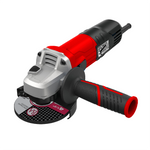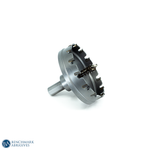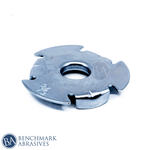
Single Cut vs Double Cut Carbide Burr

Carbide Burrs or often recognized as Rotary Burrs for metal, are widely used for cutting, shaping, grinding, and removing sharp edges, burrs, and excess material (deburring). They perform the rapid removal of excess material on metals. The carbide burrs are also used in the removal of unshaped edges. Carbide burrs are used on coated abrasives before finishing or polishing.
Carbide burrs are generally used for metalworking, tool manufacturing, engineering, model engineering, wood carving, jewelry making, welding, chamfering, casting, deburring, grinding, and plate port sculpting.
A Carbide or Rotary burr for metal is usually made either from tungsten carbide or from high-strength steel (HSS). Tungsten carbide burr bits last longer, and under higher temperatures, it doesn’t melt and perform effectively.
Types Of Carbide Burrs
Carbide Rotary Burrs are used to cut, shape, grind and remove sharp edges, burrs, and excess material, also referred to as rotary files or die grinder bits for hard steel.
Carbide Burrs are usually available in two cuts; Single Cut and Double Cut (Diamond Cut) burr.
Let’s understand them individually,
1. Single Cut Carbide Burr
A single-cut carbide burr has a spiral flute with a right-handed (Up cut). Single-cut burr is ideal for cutting hard metals such as chrome steel, hard steel, copper, cast iron, and ferrous metals. By cutting the material rapidly, a single-cut carbide burr can provide a smooth finish surface.
Applications of Single-Cut Carbide Burr:
- Heavy removal of fabric
- Milling
- Deburring
- Cleaning
- Creates long chips
2. Double Cut Carbide Burr
A Double cut carbide burr is best to use with ferrous and non-ferrous metals, aluminum, soft steel, and all non-metal materials like plastics and wood. Double-cut burr has enough cutting edges to remove excess material quickly.
Double-cut burrs are also known as diamond-cut burrs or cross-cut burrs (2 flutes cut across each other). They provide a highly smooth finish surface than a single-cut carbide burr.
Applications of Double Cut Carbide Burr:
- Medium-light removal of fabric
- Deburring
- Fine finishing
- Cleaning
- Smooth finish
- Creates small chips
Single Cut vs. Double Cut Carbide Burr (What to Use)
Single-cut carbide burrs have a right-hand (up-cut) spiral flute. These burrs are excellent to use with hard metals like stainless steel, hardened steel, copper, cast iron, and ferrous metals. Although single-cut burr comparatively provides a less smooth surface but removes material rapidly. The main application of single-cut carbide burr is to milling, deburring, and clean heavy stock.
Double-cut carbide burrs are designed to use with soft metals like aluminum and soft steel and also for all non-metal materials such as plastics, hardwood, and ceramic. Double-cut burr is also known as Diamond Cut or Cross Cut. It provides a much smoother finish than a single-cut burr as the material is cut away, so smaller chips are produced for medium-light stock removal, deterioration, finishing, and cleaning using double-cut.
Double-cut carbide burrs are the most popular for the following applications:
- Medium-light removal of material
- Deburring
- Fine finishing
- Cleaning
- Smooth finish
- Creates small chips
What are the Differences between Single Cut vs. Double Cut Burr?
Following are the major differences between single-cut burr and double-cut carbide burr:
-
Material Difference: Single-cut carbide burr is perfect for hard materials like iron, steel, copper, and other hard metals. In contrast, softer metals like wood, plastic, and aluminum work well with double-cut carbide burs.
-
Chip Extraction: Single-cut burr is not ideal for chip extraction. Double-cut burr is better for chip extraction as the burr has more grooves.
-
Surface Smoothness: Single-cut burr provides less surface smoothness. While your metal needs high surface smoothness, prefer double-cut diamond burr.
-
Operation Experience: As a beginner, It is not easy to control a single-cut burr while operating. "Burrs jumping" is the result of a single-cut burr missing the target and jumping to another location. In contrast, the Double cut burr is easy to control and handle and is an ideal carbide burr tool for beginners.
Uses of Carbide Burr Tools
These carbide burrs have wide applications in metalworking, tool designing, woodworking, jewelry making, welding, casting, deburring, grinding, porting of cylinder heads, and sculpting. Carbide burrs are also used in the aerospace, automobile, dentistry, stone, and metal industries.
Carbide burrs are best to use with power tools such as die grinders, high-speed fabricators, and hydraulic rotary tools.
How To Select The Right Burrs
Choosing between single-cut and double-cut carbide burrs depends on the factors like specific material, desired finish, and many more, and the type of operation.
-
Type of material: the type of material you are working on is also a crucial factor in selecting the right burr. Choose single-cut carbide burrs if you are working with hard materials, and choose double-cut carbide burrs if you are working with softer materials.
-
Type of Operation: this is also a deciding factor when working with carbide burrs. Select single-cut carbide burrs if you are working with aggressive and rough stock removal. On the other hand, select double-cut carbide burrs if you are working on deburring and finishing projects.
-
Required finish: the desired outcome will also help in deciding between the burrs. Choose single-cut carbide burrs if you require a rough finish, and for a smoother and more fine finish, choose double-cut carbide burrs.



































































